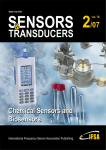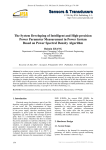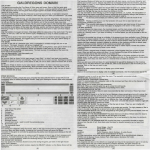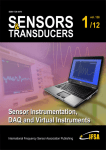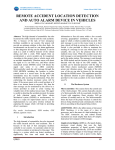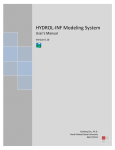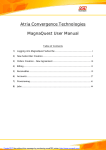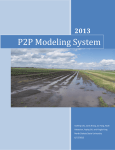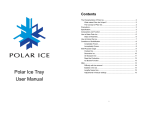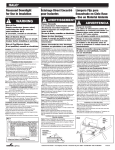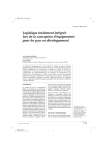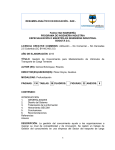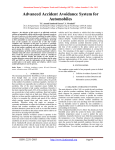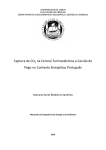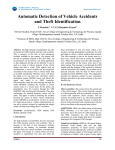Download Sensors & Transducers
Transcript
Sensors & Transducers, Vol. 178, Issue 9, September 2014, pp. 34-39 Sensors & Transducers © 2014 by IFSA Publishing, S. L. http://www.sensorsportal.com Research and Application of Digital Transmission of Unbonded Elastic Wire Resistance Type Sensor Guilin Zheng, Zhenjie Wang School of Power and Mechanical Engineering, Wuhan University, Wuhan 430072, China E-mail: [email protected], [email protected] Received: 22 June 2014 /Accepted: 29 August 2014 /Published: 30 September 2014 Abstract: By analyzing different resistance values, this collector of this article collects signal of the Unbonded Elastic Wire Resistance Type Sensor (UEWRTS in brief) acquisition embedded in the dams, reservoirs and other hydraulic buildings, and monitors the facilities in real time view. The position of embedded sensors can be distinguished by setting the address and code. The analog signal is one-on-one converted to digital signals through high-precision analog-to-digital conversion and amplification chips by digitized transducers. The digital signals are transported to the central server, and the deformation of the structure is estimated by original data in the server. Meanwhile, it extended the transformer’s effective measuring distance from normal analog 200 meters up to digitalized 1200 meters. In situation of multi UEWRTS installed field, all the output of the transformers can be connected in parallel to eliminate the cables to only one RS485-Bus as a twisted-pair cable and a power line. Applications of the transducer in several reservoir dams’ security monitoring system proof that is of high accuracy, reliable, strong anti-interference solution for all the UEWRTS applications of the relative monitoring and measurement projects. The collector has been applied in dam monitoring, and achieved good results. Copyright © 2014 IFSA Publishing, S. L. Keywords: Unbonded Elastic Wire Resistance Type Sensor, Wire resistance, Five-wire Transformer, Wire resistance, Concrete crack, Concrete temperature. 1. Introduction According to the function, Unbonded Elastic Wire Resistance Type Sensor, which is used to make long-term observation to internal structural parameters of the buildings in all kinds of construction fields, can be divided into the stress, strain and infiltration pressure, temperature, crack and so on for observation to different physical quantities [1-2]. Through the information collection of resistance sensor, the effective analysis for hydraulic structure deformations and internal temperature changes of bridges or dams can be got. With the 24-bit high-precision Analog to Digital Converter, a group of resistances from the sensor can 34 be made accurate measurement [3-4]. According to these resistances, which are taken into the formula of hydraulic structure detection, the internal deformations of several of building fields can be monitored. Such has made important significance to the lives of dwellers neighboring. Previously, through resistance sensor, the resistance can be got with the indirect method that the line resistance is measured and its value is computed [5]. Such method presents the shortcomings such as complex computation, occupying a considerable amount of resources, bringing great load to MCU. Currently the output structure of UEWRTS is five-wire system, which is taken five lines of different colors as the cable http://www.sensorsportal.com/HTML/DIGEST/P_2349.htm Sensors & Transducers, Vol. 178, Issue 9, September 2014, pp. 34-39 resistance testing of UEWRTS and the output of mutual resistance measurement [6-7]. This essay is taken five-wire resistance as background, highprecision ADS1232 as signal processing component, and NECμPD78F0881 as processing unit for intelligent signal processing, parameterization and bus. Meanwhile it takes DC-DC as the power supply for the transducer to ensure full power isolation, which can resist 2500 Vpp back-flashover over voltage. Additional the output of the sensor, photoelectric isolated RS485 signal, also has the similar level of isolation voltage. The transducer is designed in a metal rod body with 4 centimeters in diameter and 20 centimeters in length, which is facilitate to bury. According to the embedded micro-power, highperformance microprocessor and the relative signal conditioning circuit, the transducer can measure each resistance's value and its change within sensors and cable lines accurately. With the coordination and administration of the microprocessor, the transducer can achieve automatic measurement and complete correction. In addition [8], all the parameters can be set remotely by RS485 communication. The adoptive AD chip within the transducer achieves a high resolution of 24-bit. The embedded temperature chip is applied to monitor and compare the environmental parameters of the measured structure. With the AD conversion technology, the transducer can wipe off the influence and error affecting on measurement results which are caused by different lengths of resistive sensors' output cables and changes in environmental temperature. In this context, this paper takes the collector, installed in spillway dam Wuhan Daoguan-River Reservoir in China, for example, and the transducer collection and calculation of the resistance value through the embedded sensors to complete analysis the deformation and temperature of the dam. 2. Part of the Hardware As shown in the Fig. 1, the hardware includes five parts: central processing unit, power management unit, communication unit, measurement unit and five-wire UEWRTS. Central processing unit is made up of Micro Control Unit (MUC), which is the control center. Degree of intelligence is depended on MCU. Power management unit is used to support controllable energy for the communication unit, measurement unit and UEWRTS. Communication unit communicates with central sever through RS485 signals. Measurement unit is the central part of the transducer. It includes signal conditioning and AD acquisition unit and collection of temperature and storage unit. As a 24-bit high precision AD acquisition chip, ADS1232 transforms the analog signal coming from resistance devices into the digital signal. The temperature acquisition chip collects the temperature and compensates for results. The memory chip sets address and basic parameters for the transducer. The transmission unit transmits the collected information and processing results to the remote server. The working current is 25 mA. UEWRTS of the hardware is embedded previously in different acquisition positions, when the dam is building. Five wires of the UEWRTS are extended from the underground to connect with the measurement unit. Fig. 1. Block diagram of collector. 2.1. Central Processing Unit As the central processing unit, microcomputer chip NECμPD78F0881 is responsible for receiving, processing and distribution of peripheral signals of devices [9]. NECμPD78F0881 is a kind of single chip researched and developed by NEC Corp and its outstanding industrial properties make it stable and reliable in usage .This chip has abundant resources: 44 pins, the built-in single-supply flash memory, the built-in watchdog; six timers including two 16- and four 8-bit; the internal integrated 8-channel 10-resolution AD acquisition module; the internal integrated CAN controller. In the hardware, MCU commands and schedules other unit work, which plays the role of control center by exchanging information. 2.2. Power Management The transducer is responsible for collecting dam internal parameters periodically, and the practical application of the working time is far less than the non-working time. Considering low power, the power part of achieves function of controllable power by using the PMOS transistor switches to supply power on the acquisition part and UEWRTS. Power is on under control in the acquisition time. Power is off under control after acquisition time, and transducer gets into standby mode waiting to be recalled by communication or the timer. This design is conducive to extend sensor life while saving energy. 35 Sensors & Transducers, Vol. 178, Issue 9, September 2014, pp. 34-39 2.3. Communication Unit As shown in Fig. 2, ADM2483 is of enhanced isolation RS485 transceiver device, which includes a three-channel isolator, a drive controller of tri-state output, and a receiver of three-state input. The chip has thermal shutdown protection function, whose isolation voltage can reach 2500 V, and instant high common mold suppression ability can reach 25 kV/μs. These features allow the sensor to have reliable overvoltage, over current protection, and anti-jamming capability. In the application and installation system of a multi-sensor bus form, it plays an important role in protection of the entire communication bus. In addition, max emission current of the chip is only 2.5 mA. Low-power design not only conserves energy, but also reduces the chip fever, thus failures are avoided because of high fever an airtight system. and so many important parameters. According to different number of address, not only can many sensors and transducers work through parallel bus, but also multiple transducers communicate and acquire measured value based on a bus cable, and no address conflicts or packet loss can be ensured. Memory chip of 24C02 has 1K memory space, which can provide ample space for the relevant parameters of transducer to store. Calibration of the test data by the temperature can be completed by synchronous detection of ambient temperature of the sensor and transducer. The transducer integrated by high-precision temperature monitoring unit, exports resistance values, while putting out temperature of environment at the same time. Practice has proved that, the integrated temperature sensor DS18B20 has high detection speed, high accuracy, and good stability [11-12], so that the transducer can not only fully meet the demand of temperature correction, but also as intelligent transducer put out multi-parameter. 2.5. UEWRTS Fig. 2. Schematic of internal serial communication. Unbonded elastic wire resistance device is usually buried in the deeper location of the dam or a variety of architectural structures previously. Value of resistances of cables is too much to be ignored, because cables of sensors are generally long. AS shown in Fig. 3, R1 and R2 are resistances to be measured, r1, r2, r3, r4 and r5 are all resistances of the cable lines. It is because of five-wire configuration, resistances of the cables can be measured and errors are available to be avoided in the final results [13]. 2.4. Measurement Unit 2.4.1. Signal Conditioning and AD Acquisition Unit Because UEWRTS is five-ware structure, ADS1232 is chose as acquisition chip. ADS1232 is of dual-channel high-precision 24-bit ADC [10]. Integrated programmable gain amplifier (PGA) is internal of chip ADS1232, which includes a thirdorder modulator, a fourth-order digital filter and an internal oscillator. Its internal structure is able to provide a complete front-end solution for the resistance measurement sensor. The resistance of a sensor changes from 40 Ω to 120 Ω. According to the range measurement of the resistance of the sensor, the full scale measurement range is set as 120 Ω. 2.4.2. Collection of Temperature and Storage Unit Memory chips are used to store various types of transducer parameters for setting the address, range 36 Fig. 3. Five-wire Resistance. 3. The Programming As shown in Fig. 4, the program flowchart of the transducer and different sensors are distinguished by setting different addresses. The number of address of sensors can be set from 01 to 32 by digital interface of RS485-Bus. It should be noted that addresses of sensors must be assigned one-to-one before connecting with the bus, and a same address of different sensors is not allowed. After the address is assigned, the RS485 cables of the transducers connect with the central server as a bus, and master-slave mode is used in communication between multiple sensors and central Sensors & Transducers, Vol. 178, Issue 9, September 2014, pp. 34-39 server and multiple sensors [14]. Transducer responds to the central server according to the address of an instruction. When the address of the command does not match, the sensor takes no action. The first type is the core of the instruction: after receiving the order, the transducer begins to collect temperature and resistance value then transfer the value back to the collection center. When acquisition instruction is got from central service, measurement unit and UEWRTS are powered on. Values of temperature and resistances are collected, and data is packed and sent to the server. After receiving confirm instruction from the server, measurement unit and UEWRTS are powered off waiting for the next acquisition instruction. If confirm instruction is not received from the server in a certain period of time, data is sent in the second time. If confirm instruction is still not got, measurement unit and UEWRTS are powered off. The transducer, controlled by remote center of Personal Computer, gets collection cycle by configuration according to the need of the project. Transducers have four times for collecting daily: 6:00, 12:00, 18:00 and 24:00 [6], which can meet the needs of structural telemetry observations. When necessary, cycle detection can be configured fastest detection to one minute. 4. Stricture of Transducer Unbonded elastic wire resistance device is usually buried within the structure been observed, so transducer, supporting the design, must be of small size, rugged construction and can be buried. In this article, the digital transducer is divided into two parts of signal conditioning and microprocessor circuit design, and the upper and lower parts are fixed by pins, which is easy to fix within the tubular shell. The thickness of shell is 5 mm of metallic materials. As shown in Fig. 5 and Fig. 6 show, the transducer can be directly buried near the resistance for its solid structure, so it can complete digital transmission of analog sensors in the nearest place; advanced isolation technology of power supply and digital output communication interface of the transducer has been taken; electrical standards of capacity of counter-attack voltage 2500 Vpp in RS485 and power supply against lightning can be achieved [15]; grade IP68 of the waterproof from overall structure of the transducer can be reached; capacity of bearing 400 kg/cm2 geotechnical engineering requirements can be achieved. Fig. 5. Side view of internal structure. Fig. 6. Top view of internal structure. 5. Practical Application and Analysis Taking one used in a large reservoir spillway as an example, the transducer of the research, the spillway has 18 resistive sensors buried in the construction process. The buried sensors are divided into two categories: first class for the deformation detection; second class of observations for the temperature. After the transducers are digitalized respectively, corresponding addresses are: address 01 to 15 for the first category; address 16 to 18 for the second category. Set resistances as R1 and R2 of a resistance sensor. The usual method of detection is to calculate ratio Z of two resistances: Z = 10000 × R1 / R2 , Fig. 4. The program flowchart. and detection of resistance and R is: 37 Sensors & Transducers, Vol. 178, Issue 9, September 2014, pp. 34-39 Table 2. Result of measurement (Temperature oC). R = R1 + R2 When the dam is built, the crack length of the dam is measured as basic value. The data calculated by UEWRTS is actually crack variation [16-17]. Set the crack variation as L; T as the observed temperature; f as minimum readings for the sensor; b as resistance reference value for the temperature correction coefficient; t as the temperature; R0 as benchmark, when UEWRTS is just out from the factory; t1 as the temperature constant when R> R0; t0 as temperature when constant R <R0; Z0 as baseline resistance ratio when resistance sensor was just out from the factory. So detection function of temperature T and crack length L are as follows: T = t × ( R − R0 ) No. 6:00 12:00 18:00 24:00 Average value 1 27.30 27.31 28.55 27.36 27.63 2 19.85 19.87 20.35 20.02 20.02 3 22.56 22.58 23.84 22.56 22.89 4 14.00 14.04 14.59 14.34 14.24 5 20.14 20.11 19.98 20.17 20.10 Fig 7 shows the curve of crack length of UEWRTS for one month. (1) If R > R0 , t = t 0 . If R < R0 , t = t1 . L = f × (Z − Z 0 ) + b × (T − T0 ) (2) Formula of the second class is shown as (1). In this subject, f, b, t0, t1, Z0, T0 and R0 are known quantities. Formula (1) is used in second category and (1) and (2) in first category. According to one day of sunshine and dam temperatures, 4 observation time points – 6:00, 12:00, 18:00 and the 24:00 are set, and the data of following two tables were collected on July (Tables 1, 2). Change of the dam, can be seen from different points in every day, is not significantly, which proves that the collector is working stable and reliable. Fig. 7. Curve of crack length. Fig. 8 shows the curve of temperature of UEWRTS for one month. Table 1. Result of measurement (Crack variation mm). No. 6:00 12:00 18:00 24:00 Average value 1 1.83 1.85 1.87 1.86 1.85 2 1.49 1.47 1.33 1.31 1.40 3 0.58 0.56 0.57 0.58 0.57 4 2.29 2.22 2.24 2.25 2.25 5 1.54 1.67 1.67 1.69 1.64 6 3.83 3.77 3.74 3.83 3.79 7 1.55 1.60 1.54 1.53 1.55 8 4.75 4.74 4.74 4.74 4.74 9 2.48 2.49 2.39 2.33 2.42 10 2.54 2.51 2.76 2.79 2.65 11 -1.71 -2.15 -1.84 -1.99 -1.92 12 -13.27 -13.25 -13.37 -12.95 -13.21 13 -3.68 -3.67 -3.59 -3.95 -3.72 38 Fig. 8. Curve of temperatures. 6. Conclusions This paper explores the resistance of the sensor signal to achieve one-to-one place directly converted to high-precision digital signal, and put out by the RS485-Bus. This paper focuses on the technology of signal conditioning and digital bus of resistance type sensor, which is widely used in hydraulic construction, bridges and other projects. Results in the project has a great significance, for it can be up to 32 sensor clusters, achieve measurement to bus cascade, greatly reduce the number of live cable laying, and improve the measurement accuracy of the sensor and anti-jamming capability. According to the practice and the data argument, it has been described in this paper that the transducer has the following five technical innovations: 1) The application of differential resistance sensor is no longer troubled by length the cable and Sensors & Transducers, Vol. 178, Issue 9, September 2014, pp. 34-39 cable resistance. More than 32 sensors can be hooked up on the R485-Bus, which has greatly improved the reliability of the system, and reduced the intensity and difficulty of construction; 2) A number of sensors distributed multi-cable installation has been solved, and convergence of separate cables can be achieved by using communication bus, so transmission cables can be extended from 200 meters to more than 1200 meters; 3) One-to-one monitoring mode, making installation easy and maintenance free, can achieve remote configuration of the parameters and dynamic monitoring sensors online and remotely. 4) Local digital process makes the detection accuracy of the sensor fundamental guarantee. Digitization and Parameterization make the adaptability and accuracy of differential resistance of the sensor higher, which improves the applicability of the differential resistance sensors; 5) Reliability and lifetime of the sensor will be greatly extended, for there is no longer subjecting to over voltage threats by lightning counterattack. This thesis has unique features in the signal conditioning, and incenting of differential resistance of the sensor, in particular, the results put an end to the shortcomings of the differential resistance sensors, and improve long-term stability and detection accuracy of the differential resistance sensor in the scope of application of various types of construction industry. So it has a very important reference. Acknowledgements This work was supported by the National Natural Science Foundation of China (No. 61272114) and Marine Renewable Rnergy Projects of State Oceanic Administration 2013 of China (No. GHME2013JS01). References [1]. S. Huaizhi, L. Jinyou, H. Jiang, Analysis and backanalysis for temperature field of concrete arch dam during construction period based on, IEEE Sensors J., Vol. 13, 2013, pp. 1403-1412. [2]. N. M. Mohan, G. Boby, K. V. Jagadeesh, Analysis of a sigma-delta resistance-to-digital converter for differential resistive sensors, IEEE Trans. Instrum. Meas., Vol. 1617-1622, 2009, pp. 1617-1622. [3]. M. D. Ramírez, M. J. Sánchez, E. C. Reig, Constant current drive for resistive sensors based on generalized impedance converter, IEEE Trans. Instrum. Meas., Vol. 57, 2008, pp. 2290-2296. [4]. N. M. Mohan, G. Boby, K. V. Jagadeesh, A sigmadelta resistance to digital converter suitable for differential resistive sensors, in Proceedings of the Rec. IEEE Instrum. Meas. Technol. Conf., 2008, pp. 1159-1161. [5]. N. Viet H., C. Phillip, H. Anco, An analysis of the effect of wire resistance on circuit level performance at the 45-nm technology node, in Proceedings of the Int. Intercon. Technol. Conf., 2005, pp. 191-193. [6]. Maiti, Tapan Kumar, A novel lead-wire-resistance compensation technique using two-wire resistance temperature detector, IEEE Sensors J., Vol. 6, Dec. 2006, pp. 1454-1458. [7]. S. Rescia, V. Radeka, Effect of sense wire resistance on readout noise of large liquid argon time projection chambers, in Proceedings of the IEEE Nucl. Sci. Symp. Conf. Rec., 2009, pp. 1932-1935. [8]. S. Wendong, Song, J., Z. Xinjun, Design of weighing transmitter in corn yield measurement system, in Proceedings of the International Conference on Electric Information and Control Engineering (ICEICE'11), 2011, pp. 324-327. [9]. Preliminary user’s manual of 78 K0/FC2 (8-Bit single-chip Microcontrollers), NEC Electron. Corp., Tokyo, Japan, 2005. [10]. J. Vedral, P. Fexa, ADC and DAC testing using impulse signals, in Proceedings of the IEEE Int. Mixed-Signals, Sensors Syst. Test Workshop (IMS3TW), 2011, pp. 96-99. [11]. L. Ping, Z. Yucai, Z. Xiangjun, A design of the temperature test system based on grouping DS18B20, in Proceedings of the Second IEEE Conf. Indust. Electron. Applic., 2007, pp. 188-191. [12]. Z. Xuefeng, L. Weijie, Z. Lei, Active thermometry based DS18B20 temperature sensor network for offshore pipeline scour monitoring using K-means clustering algorithm, Int. J. Distrib. Sens. Netw., Vol. 2013, 2013. [13]. S. K. Sen, T. K. Pan, P. Ghosal, An improved lead wire compensation technique for conventional four wire resistance temperature detectors (RTDs), Meas J Int Meas Confed, Vol. 44, 2011, pp. 842-846. [14]. D. Tuan Thanh, K. Jin Ho, N. Dung Duc, A gateway for multi-device communication between Mechatrolink-III and RS-485, in Proceedings of the 12th International Conference on Control, Automation and Systems (ICCAS'12), 2012, pp. 294-299. [15]. W. Yanfang, M. Wandui, L. Jinying, A distributed rectifier testing system based on RS-485, in Proceedings of the 5th IEEE Conference on Industrial Electronics and Applications (ICIEA'10), 2010, pp. 779-781. [16]. A. Bernieri, G. Betta, L. Ferrigno, Crack depth estimation by using a multi-frequency ECT method, IEEE Trans. Instrum. Meas., Vol. 62, 2013. [17]. Z. Zhijun, A. Farhad, Fiber-optic laser speckleintensity crack sensor for embedment in concrete, Sens Actuators A Phys, Vol. 126, 2006, pp. 107-111. ___________________ 2014 Copyright ©, International Frequency Sensor Association (IFSA) Publishing, S. L. All rights reserved. (http://www.sensorsportal.com) 39







